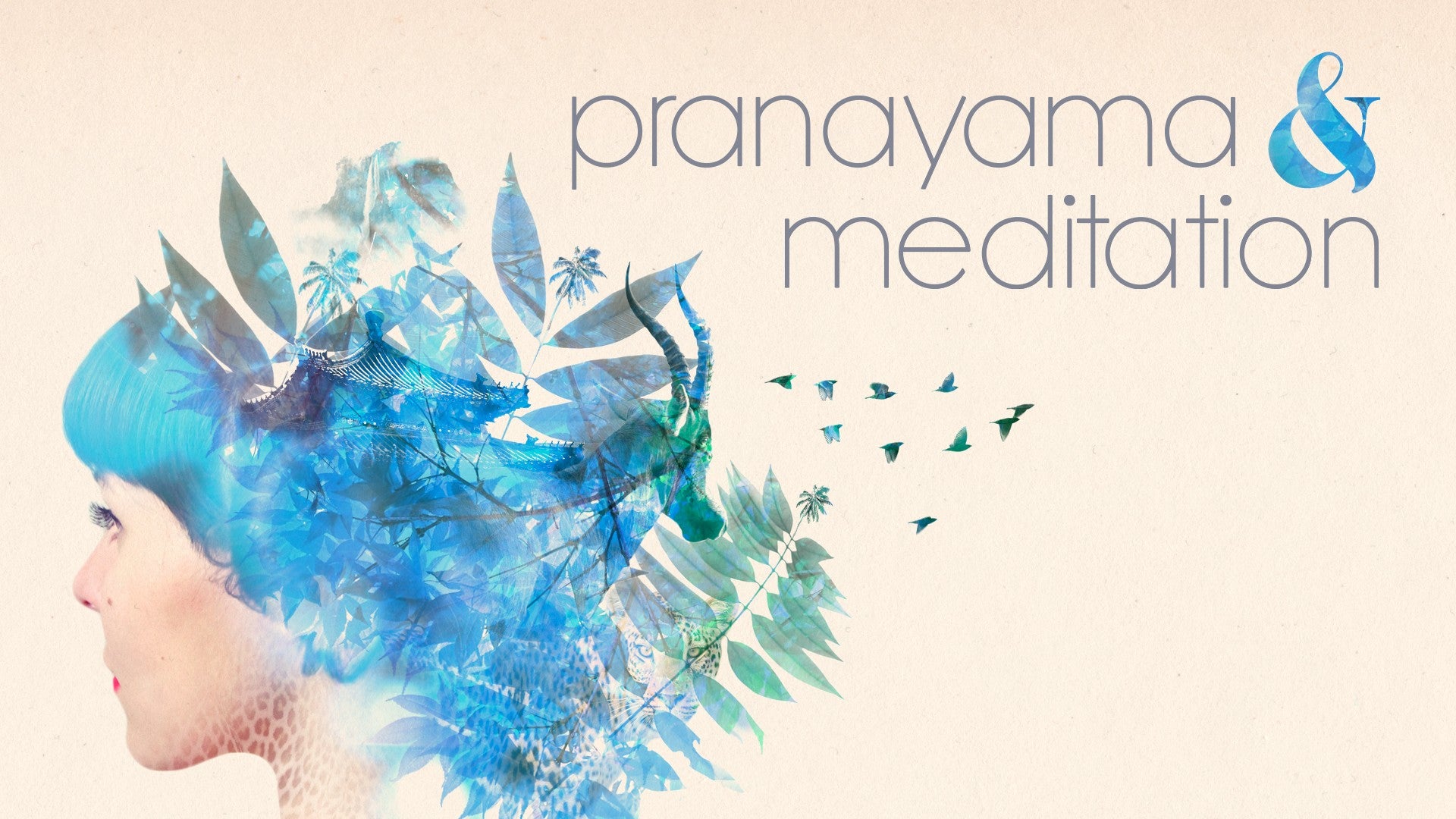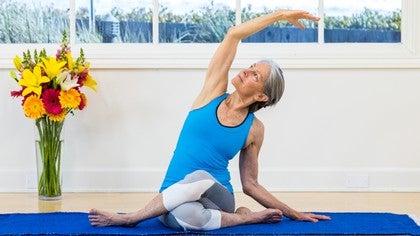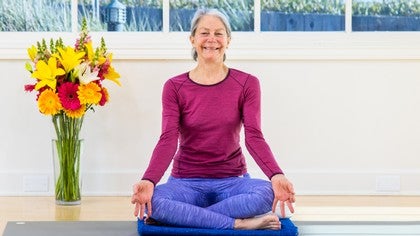Description
About This Video
Transcript
Read Full Transcript
Hi there, welcome. This practice is going to be a breathing practice using the fingers to touch the nostrils and a meditation following that. This practice is called nadi shodhana, n-a-d-i, shodhana, and it means clearing or purifying the channels, nadi channels. The nadi channels are energetic channels that run through our system, not unlike meridians, but not the same. They're not vessels like blood vessels, they're just places where the energy flows.
And when we can purify the left and right channels that run from the nostrils down along the spine, the central channel right and left, sometimes our awareness, sometimes that's enough just to do a little clearing like that, but sometimes our awareness will go right into the center. And that centered awareness along the spine is considered to be a portal or a pathway into a deeper state. So we'll just see what happens. Generally speaking, our breath is flowing more clearly and more easily through one nostril and down into the lungs than it is through the other side. And so in this practice, we will block one side entirely and breathe into and out of or out of and into the other side, which is either not blocked at all or partially blocked.
The part of the finger that we use in nadi shodhana is the tips of the fingers. It's not the pads of the fingers. The pads of the fingers and the tips of the fingers are both rather sensitive, but the smallness of the tip of the finger and the sensitivity here is very helpful because you don't want to be smashing the whole nostril closed as you're doing this. And it's amazing what slight amount of pressure you can put from the outside towards the center of your nostrils and have that nostril blocked. So the positioning that you use with your hands can either be thumbs touching forth and pinky with the index finger and the third finger touching the third eye, which I don't like to do.
I like to curl it down. I feel like this is a distraction to have something touching there. However, sometimes, like I have a student whose first knuckle doesn't bend. It's like, what are you going to do? You can't really do this curl thing.
So you work with what you can do. And if you have long nails, maybe you can't quite use the tips. Maybe you have to move a little more towards the pads. Anyway, I'm going to just demonstrate the touch with my two index fingers, and then I'll switch to this position where you curl index finger and thumb, index finger and third finger into the center of your palm. And then you curl your fingers and your thumb so that the tips come together.
And they don't have to open very far apart, but a little bit. So just sit here for a moment, and as you're breathing, bring your awareness along the inside of your nostrils as the breath is coming and going, going and coming. In these first few breaths, you're honing and narrowing your awareness to feel the sensations as the breath comes in and goes out. Don't think of taking a breath. Think about receiving a breath, allowing a breath to come in, releasing the breath and letting it go out.
So it doesn't matter so much which side is blocked, just to notice that one side might not be flowing as freely as the other side. And I'm going to just suggest that you use both index fingers, the tips of both index fingers. And you're going to come in to the part where the nostril, the rounded part of the nostril meets the crease. And I press just a little bit more on the rounded part of the nostril than the crease. So try that.
And just move the fingers towards the midline a little bit, breathing out. And as you breathe in, that slight pressure inward will partially block and therefore slow down your breath. And keep it partially blocked as you breathe out and in again. Eyes are very still, breathe and let the breath go out and release the fingers. Okay, so the next little awareness will be after letting your breath go completely out and in with both fingers, you're going to press a little more firmly with your right finger into the right nostril.
And if you find that the left nostril is too blocked to bring in any breath, you can just slightly remove it entirely or sometimes you can place the finger on the cheekbone and pull slightly laterally to the side, which will reopen that nostril if it's gotten blocked. Okay, sometimes the mucus membranes start to stick together. Alright, so here we go, just be relaxing down with your shoulders, there's a slight downturn of the head, but it's not a nod, it's chin back releasing over the crown. Inhale and exhale, place your fingers equally, inhale and exhale with just the slightest amount of pressure. After your next inhale, press a little more firmly into the right nostril and allow the breath to come in through the left side only.
And for now I'm going to have you breathe out through the left side as well and in again and out again and then remove both hands. Now we'll switch to the other side and again a very delicate touch coming up, meaning that we'll block the left side as you're breathing. So first very equal touch, left and right index fingers, the tips into this flaring part of the nostril right near the crease, pressing in just a wee bit. Let's start with an exhalation here, so inhale, then bring the touch in, let your breath out, bring it in again, out and in one more time. Now as you get ready to let the breath out again, move your left nostril inward with a slightly stronger pressure on the left side and breathe in through the right.
You can pull the cheek out if you need to. Do your in breath, breathe out, one more in and out, very delicate. Release both index fingers when you're done with that out breath, bring your hands back into your lap. So because that was just an exercise, I sort of flipped the normal order of things. Generally speaking you'll start with the digital pressure into your nostrils at the beginning of an exhalation and every time you have filled one side, you switch to the other side before breathing out.
So there's the awareness into the nostrils, very finely tuned awareness into the nostrils and you may or may not be able to extend that awareness into the body. But since the nostril mucous membranes are so sensitive, it's best probably in the beginning to just keep your awareness into that very sensitive area and that expands into the whole system. So now I'm going to talk about the hand position again. You're going to curl your index and third fingers in towards the palm. If your fingers don't curl in that way, I'll give you an alternative in a moment.
And then your fourth finger and pinky come together towards the thumb. I'm going to use my right hand to start with. You might not be able to see what's going on when I bring my hands up here, but it's the same thing that was going on when you were just touching with your index fingers. Some people encourage trying to touch with both the pinky and the fourth finger. It depends on your fingers.
If your fingers are kind of robust and large, you're not going to need to touch with both. For me, my fourth finger touches right where the crease of the nostril is and my pinky touches just a little bit below that on the flare of the nostril, very delicately. But for you, it might just be the one finger of the fourth. Alright, so the other thing is what are you doing with this arm? Because hinging the elbow up brings the hand down, you need to keep your elbow pretty much, if you can keep your forearm pretty much vertical, shoulder relaxed, and instead of turning your head towards your hand, you want to endeavor to keep your head in the center.
This is all about centering and purifying, so bring your hand across. And again, there may be a tendency to slip towards coming onto the pads of the fingers, so you have to keep observing that. It's a lot of observing and adjusting, observing and adjusting, and with that discipline, with that loving kind attention, it unfolds, it gets easier, and it's very powerful, and you don't have to do a bunch of these. Okay, so we'll probably just do three cycles, which is in and out on one side, or out and in on one side, out and in on the other is one cycle. So don't take anything.
Allow your body to release and open into a nice, full breath. Allow it to go out again. By the way, in Nadi Shodhana, there's no ujjayi, there's none of this closing of the throat, because the delicacy of what happens in the nostrils will be lost to your attention. You won't be able to hear it, you won't be able to feel it, so your breath is as silent as you can make it, and you're bringing in the breath as though you're trying to taste each and every particle of breath. All right, so here we go, here's the positioning.
There's this chin ever so slightly back towards the base of the skull and the energetic of the flow over and down the crown. Inhale and as you exhale, both sides are going to touch and allow the breath to come out equally. Very delicate touch as you exhale. Inhale both sides equally as possible. When you're full, press a little more firmly with the right thumb.
Inhale through the left side with just the slightest amount of pressure or none. Breathing in and down. Breathe up into the eyes. Exhale switch sides, press the little finger and fourth finger, pull the cheek away if you need to with the thumb, breathing in or out, and in again. Slightly firmer pressure with the right hand, right thumb, breathe out, left side, and breathe in again.
Having filled to 85 or 90% switch sides, press with the little finger and fourth finger, breathing out. Very delicate touch or no touch at all, pulling the cheek open if you need to, out and in on the right side. Having filled, press the right thumb into the right nostril, breathing out and in through the left. If you can slightly block the nostril, it will slow your breath. After this inhalation, use the thumb and the fourth finger to spread both cheeks a little bit away from the nostrils and breathe out both nostrils.
And then slowly let your hands come away and come down into your lap or onto your knees. And just notice how the breath is flowing in and out of your nostrils, your eyes closed. There's one more little hint that I want to give to you. So open your eyes again. And here it is.
This has been very powerful understanding for me over the years. That on the inhalation, because there is a tendency for the breath to want to go straight up into the eyes and the brain instead of in and down, with that very slight touch of either the little finger and the fourth or the thumb, while you're breathing in, you tug just a little bit down on the outside of the nostril. I can feel that pulling on the skin of my forehead. I can feel that encouraging the movement of the brain downward and discouraging the movement of the breath to go up. It's just the lightest touch, but it makes a huge difference for keeping the mind calm and passive and very much awake.
So let's just try that. Curl your index and third finger down. You can even use your other hand to hold them down, while you curl the thumb and fourth and fifth fingers down. Sometimes I'll meditate with my hands like this, just to train them, both of them, to be able to stay there, which is a muscular something that has to happen to hold them. So anyway, we're going to start this cycle on the left side, the left nostril.
So your hand is ready. You're going to inhale through both nostrils, placing your thumb and fingers. Exhale just a light touch to slightly block the left side. And as you begin to inhale, just the slightest amount of downward tug on the outer nostril as you're breathing in and down. Then gently block the left side and open the right.
You're going to be breathing out now. And then as you breathe in, it can be the cheek if you can't touch the nostril, if it's too close, but touch the, there's a slight downward tug to allow for that calm contrast of the upward breath. And then we'll finish with an exhalation with both sides, either fully open or partially block if you can do the partial blocking, letting the breath out. Let your hand come down and rest on your lap at the end of that out breath. And just continue touching into the refinement of the breath flow with the touch in the nostrils, feeling also peripherally how the breath moves down into your belly and up towards your chest.
But the central focus is the nostril. You're in this very centered space with this delicate, careful, loving attention. So let's just stay here for a while. And I'll bring us back out in five minutes or so. You can be here in complete silence.
Silence doesn't necessarily hold. Thinking comes, but allow your awareness to expand around and beyond and above and below the thinking, the awareness from your heart, your mind, your brain, and settle. Silence, silence. Thank you. Thank you.
Perhaps you can get a glimpse of how the universe is holding you and holding this space for you. For whatever is happening inside. Thank you. Thank you. Thank you.
Thank you. Thank you. Thank you. Still aware of your inner process, your breathing, if your eyes have closed. Let them open just a little bit so that you have a slightly downward gaze unfocused.
Sometimes it's very beneficial to work and sit with the eyes open sometimes because we're not closing the world out, we're opening to everything. For now we're going to let this moment go, let your eyes come back up to eye level. Perhaps you'll meet my gaze. I want to thank you for your practice, for your sincere attempt to get to know yourself. And I sincerely hope that these practices are beneficial for you.
Bring your palms together in front of your heart.
Pranayama & Meditation: Patricia Sullivan
Comments
You need to be a subscriber to post a comment.
Please Log In or Create an Account to start your free trial.













